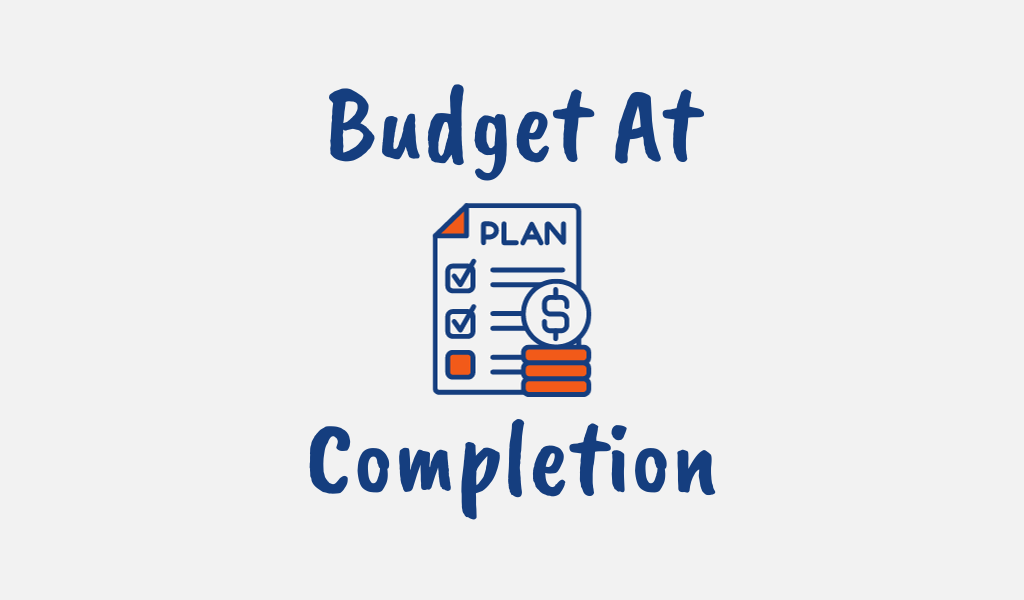Managing project costs is a vital skill for any project manager. To do this, it is important to have clear visibility into the approved budget baseline, and consistently track the performance of the project as it is executed against that benchmark.
The Budget at Completion (BAC) of a project is a key component of earned value management and sets the cost foundation. It represents the total authorized budget allocated for a project before it begins.
As project work progresses, the BAC is compared against Earned Value metrics as work progresses to analyze if the project is over or under budget.
In this post, we’ll explore the Budget at Completion definition, how it is determined, how it fits into broader earned value calculations for project cost control, and tips on mastering the concept for the PMP certification exam if you are preparing for it.
What is Budget at Completion (BAC) in Project Management?
The Budget at Completion (BAC) represents the total budgeted cost for all the work planned for a project. It is the original estimated cost for the project before any work begins.
The BAC serves as a key cost baseline that you can use to track and analyze project performance throughout the project lifecycle.
As work is completed, BAC is compared to the Earned Value (EV) to determine if the project is over or under budget.
The BAC does not change during project execution unless the scope significantly changes. It is determined upfront during project planning and budgeting.
Accurately forecasting the BAC sets the stage for effective project cost management and allows the use of Earned Value Management (EVM) techniques.

Budget at Completion Formula
While the Budget at Completion represents the total estimated cost for a project, there is no single BAC formula in project management.
Instead, the BAC is calculated by adding together cost estimates for all of the required work and deliverables in the project.
The methods for deriving these individual cost estimates include techniques like analogous estimating, parametric estimating, and expert judgment.
These techniques help determine the costs for each project activity and component. The total BAC is the sum of all these individual cost estimates.

How to Calculate Budget at Completion (BAC) in Project Management
There are several techniques that you can use to accurately estimate the total Budget at Completion (BAC) for a project:
Analogous Estimating
With analogous estimating, the BAC is determined based on the actual costs of a previous, similar project.
This technique is most applicable when the current project closely resembles past projects.
To use analogous estimating, project managers identify a comparable project and map the major deliverables from that project to the current one.
The actual costs from the comparable project become the basis for estimating the current project’s BAC.
While analogous estimating is quick and easy, it is entirely dependent on having a project with significant similarities to produce a reliable BAC.
Parametric Estimating
Parametric estimating involves breaking down project deliverables into components, and then assigning costs to each component. These individual costs are summed to derive the total BAC.
For example, if a project requires developing 5 e-learning courses, and each course costs $1000 based on historical data, the BAC for course development would be 5 * $1000 = $5000.
This technique relies on having robust historical data on project costs as the BAC accuracy is dependent on the underlying cost parameters.
Expert Judgment
BAC can also be forecasted using expert judgment from subject matter experts. Experts who have worked on similar projects can provide estimated costs for project activities and deliverables.
Multiple experts may need to be consulted to provide a rounded BAC estimate. Expert judgment works best when experts have deep domain expertise to produce accurate estimates.
By using these techniques individually or in combination depending on the project nuances, you can derive a realistic BAC to baseline project costs for earned value management.

BAC in Project Management Example
Let’s look at an example to understand how to calculate the Budget at Completion (BAC) for a project.
Envisage a scenario where you as a project manager are tasked with building a new mobile app for a client. The major deliverables are:
- User research to define requirements:
- UI/UX design for the app
- Development of the mobile app
- Testing and QA
- Launch activities like marketing
By working with the technical team to estimate the costs for each major activity based on expertise and previous project experience, you can calculate the total BAC is calculated by summing the individual cost estimates:
- User research: $5,000
- UI/UX design: $8,000
- Development: $55,000
- Testing: $7,000
- Launch: $10,000
BAC = $5,000 + $8,000 + $55,000 + $7,000 + $10,000 = $85,000
This $85,000 BAC will serve as the cost baseline for tracking performance with Earned Value metrics like Actual Costs and Planned Value.
Can Budget at Completion Change?
While the BAC is typically fixed for the duration of the project, it can change if the project scope increases or decreases significantly.
Any major scope changes would warrant updating the BAC to match the new work requirements. Otherwise, the BAC remains constant as the cost benchmark.
Difference Between Budget at Completion and Planned Value
The Budget at Completion (BAC) and Planned Value (PV) are two important metrics used in Earned Value Management (EVM).
They however have distinct definitions and use cases as shown below:
- BAC represents the total approved budget for the entire project at the outset. It serves as the cost baseline.
- PV represents the value of work that was planned to be completed by a certain point in time. It measures work performance against the project plan.
BAC is determined upfront during the planning phase by estimating the costs of all authorized work needed to complete the project and remains fixed unless the scope changes.
In contrast, PV is measured throughout project execution to evaluate progress. It tracks earned value against planned value. PV will increase as more work is completed.
For example:
- A project has a $100,000 BAC meaning the total budget is $100k.
- After 2 months, the PV = $20,000 meaning $20k worth of work was planned to be done by that point.
The BAC sets the total budget baseline while PV is used to analyze schedule and cost performance against the baseline.
While the BAC remains constant barring significant changes to the project scope, the PV changes over time.
Difference Between EAC and BAC in Project Management
Similarly, the Budget at Completion (BAC) and Estimate at Completion (EAC) are both important metrics for forecasting project costs.
While both deal with total project cost, they differ in intent and when they are defined:
- BAC represents the original total budget approved for the project before it begins.
- EAC represents the revised expected cost to complete the project based on progress and performance so far.
The BAC provides the initial cost baseline or benchmark to measure against. It is determined upfront during planning by estimating the costs of all authorized work.
The EAC provides an updated forecast of total costs as the project unfolds. It considers factors like cost overruns or underruns to date.
For example:
- A project has a $100,000 BAC meaning the initial approved budget is $100k.
- After 3 months, an EAC is calculated as $120,000 based on costs incurred and estimates to complete the remaining work.
The BAC remains fixed while the EAC is updated throughout the project lifecycle. Comparing BAC and EAC indicates if the project is over or under budget. They provide complementary data points for forecasting costs.

Budget at Completion PMP Exam Tips
Budget at Completion (BAC) is a key concept in the PMBOK’s project cost management knowledge area.
The BAC is the total authorized budget assigned to the project and is used in assessing project cost performance.
To calculate the BAC, it’s important to understand the process of determining the budget, which is part of the planning process group.
The project’s cost baseline, which is the approved version of the time-phased project budget, excluding any management reserves, forms the BAC.
For the PMP exam, remember that BAC figures are used in Earned Value Management (EVM) calculations.
Specifically, the BAC is used in determining the Cost Performance Index (CPI) and the Estimate at Completion (EAC).
A key tip for the PMP exam is to familiarize yourself with these formulas:
• CPI = Earned Value (EV) / Actual Cost (AC)
• EAC = BAC / CPI
The PMBOK also emphasizes that changes to BAC should be treated as changes to the project scope and therefore should be formally controlled.
Understanding this relationship between scope change control and BAC is crucial for the PMP exam.
Here are some more tips for answering PMP exam questions on Budget at Completion (BAC):
- Know that BAC represents the total approved budget for the entire project and serves as the cost performance baseline.
- Be able to explain techniques for determining BAC like analogous estimating, parametric estimating, and expert judgment.
- Recognize that BAC is determined upfront during planning, remains fixed during execution, and is compared to Earned Value (EV) to assess cost performance.
- Understand how BAC differs from Planned Value (PV), which measures work performed against the plan.
- Be able to compare BAC to Estimate at Completion (EAC), which forecasts total expected costs based on performance to date.
- Review BAC formulas like Budget, where BAC = Budget. Do not expect complex BAC calculations.
- If given project data, be able to calculate the BAC and interpret how it impacts other EVM metrics.
- Expect scenarios on determining, tracking, and forecasting project costs using BAC and other metrics.
Final Thoughts
Having an accurate Budget at Completion (BAC) provides the critical cost baseline to manage projects successfully.
As a project manager, understanding techniques to determine a realistic BAC and properly leveraging it alongside Earned Value metrics allows you to estimate costs, track performance, and forecast total spend.
While simple in concept, BAC is a foundational component for controlling project budgets.
The ability to accurately budget projects before they begin and compare them against actual costs is an essential project management skill for delivering within constraints.





